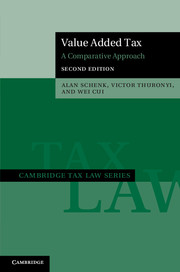Book contents
- Frontmatter
- Dedication
- Contents
- List of Tables and Charts
- List of Cases
- Preface to the Second Edition
- 1 Introduction
- 2 Consumption Tax Forms and Base Alterations
- 3 Varieties of VAT in Use
- 4 Registration, Taxpayer, and Taxable Activity
- 5 Taxable Supplies and Tax Invoices
- 6 The Tax Credit Mechanism
- 7 Introduction to Cross-Border Aspects of VAT
- 8 Timing and Valuation Rules
- 9 Zero-Rating, Exemptions, and Exempt Entities
- 10 VAT Evasion and Avoidance
- 11 Gambling and Financial Services (Other than Insurance)
- 12 Insurance
- 13 Real Property
- 14 An Anatomy of the Chinese VAT
- 15 Interjurisdictional Aspects
- Appendix VATs Worldwide
- Index
10 - VAT Evasion and Avoidance
Published online by Cambridge University Press: 05 February 2015
- Frontmatter
- Dedication
- Contents
- List of Tables and Charts
- List of Cases
- Preface to the Second Edition
- 1 Introduction
- 2 Consumption Tax Forms and Base Alterations
- 3 Varieties of VAT in Use
- 4 Registration, Taxpayer, and Taxable Activity
- 5 Taxable Supplies and Tax Invoices
- 6 The Tax Credit Mechanism
- 7 Introduction to Cross-Border Aspects of VAT
- 8 Timing and Valuation Rules
- 9 Zero-Rating, Exemptions, and Exempt Entities
- 10 VAT Evasion and Avoidance
- 11 Gambling and Financial Services (Other than Insurance)
- 12 Insurance
- 13 Real Property
- 14 An Anatomy of the Chinese VAT
- 15 Interjurisdictional Aspects
- Appendix VATs Worldwide
- Index
Summary
Introduction
As with any tax, the VAT presents opportunities for tax avoidance and evasion. While some specific areas where avoidance and evasion occur have been discussed throughout this book, this chapter focuses on evasion and avoidance more generally. We use the standard terminology, with tax evasion meaning illegal behavior (usually involving fraud or concealment of facts from the tax administration) and tax avoidance meaning behavior that follows the letter but not necessarily the spirit of the law.
Avoidance
VAT avoidance transactions can take a number of forms. For example, a taxpayer may attempt to split a supply into several parts, some of which are exempt or zero-rated. A taxpayer carrying out both exempt and taxable supplies can carry out transactions aimed at manipulating the allocation of inputs to taxable supplies. If certain favorable treatment (e.g., the registration requirement or, as in the Ch’elle case discussed later, the requirement to use the accrual method) is based on a threshold amount of supplies, a taxpayer might fragment its business, so that each part of the business falls below the threshold.
To counter tax avoidance, the tax authority must of course first identify the tax avoidance transactions that it considers questionable. Although this takes some care, it is generally easier than uncovering tax evasion, because by dei nition tax avoidance does not involve the misstatement of facts or their willful concealment from the authorities. If that happens, then one enters the realm of tax evasion.
- Type
- Chapter
- Information
- Value Added TaxA Comparative Approach, pp. 311 - 346Publisher: Cambridge University PressPrint publication year: 2015



